
“Wyoming County, Pennsylvania, has been without any House of Worship of the historical Church hitherto although an organization, St. Peter’s Free Church, has existed for about twelve years in Tunkhannock, the County Seat. A lot was purchased and a quantity of stone bought about that time but services were only held occasionally for many years. The Rev. George D. Stroud is actively and usefully engaged at Tunkhannock … doing missionary work … hitherto the congregation has met in one and other hired hall. They are few in numbers and not rich in resources. They have an eligible lot paid for. They are encouraged by the generous zeal of their minister in making an effort to build a little chapel in which to worship God. And the Rev. Mr. Stroud is endeavoring to secure help for them. I pray to God to crown his effort with success.”
This 1882 article appeared in an early Diocesan publication, and describes the start of St. Peter’s Episcopal Church. A charter was approved for the incorporation of St. Peter’s on August 20, 1870. One of the first recorded meeting places of the congregation was in October 1880 in the Platt’s Opera House, Tunkhannock. In January 1881, services moved to the third floor of the Billings establishment. The Rev. Mr. Stroud was indeed crowned with success in the spring of 1883. St. Peter’s Episcopal Church on Second Street, Tunkhannock Borough, was completed, and on May 21, 1884 was consecrated, debt free, by the Rt. Rev. M.A. DeWolf Howe, Bishop of Central Pennsylvania. The Rev. George D. Stroud served St. Peter’s during these years of accomplishment, leaving in 1886.
Additional historical record of Saint Peter’s during the late 19th century is recorded in the History of the Diocese of Central Pennsylvania, 1871-1909: And the Diocese of Harrisburg, 1904-1909, Volume 1, By Jonathan Wesley Miller. This record is written from an apparent eye witness (“The Rev. Mr. Barker discontinued his work here…”)
“TUNKHANNOCK, St Peter’s Church: In 1872, St Peter’s was admitted into union with the Convention of the Diocese. During these years only occasional services were given by neighboring Clergymen. The Rev George H. Kirkland, Rector at Montrose, had charge of this work during part of the year 1872, the whole of 1874 and 1875, until June when he withdrew from the field. These services were at first held in the Court House and afterwards in a hall. After The Rev. Mr Kirkland’s withdrawal, there were no services held here until January 1st 1881, when The Rev. George D. Stroud took charge. The Mission at this time owned a lot, and on May 7th 1882, the Rector began soliciting subscriptions for the erection of a new Church. Ground was broken on the 7th day of the following September. This new Church was finished early in November 1883, and opened for service on the 11th. A beautiful window was placed in the chancel, in memory of Dr. Minor Kelley, and wife by their daughters.

St Peter’s Second Street location
From this time, Lay services were given by The Hon. R. R. Little, until June 1st 1890, when The Rev. T. B. Barker took charge as locum tenens. In 1890, this Mission had twenty eight Communicants, thirty one members in the Sunday School, a Church valued at $4,000 and free of debt. The Rev. Mr. Barker discontinued his work here on October 5th, 1890. St Peter’s thus became vacant again and continued so until the following month, November 30th, when The Rev. T.B. Barker settled here as Rector, but only continued in charge until some time during the year 1891, when he resigned. This Mission continued vacant from this time until July 19th 1894 when The Rev. William Coney became Minister in charge. About this time a new floor was put in the basement and a furnace in the Church. During part of the year 1895, Mr. Felix Ansart, Lay Reader, read the service on alternate Sunday mornings. The Rev. Mr. Coney resigned on February 21st, 1896. This work was then placed in charge of The Rev. John W. Burras, Rector of St. James Pittston, who gave services here during the year 1896. From this time, St. Peter’s was supplied with Lay services. In 1900, a brass book rest and Clergy stalls were presented to the Church, and a stone walk put down in front of the Church. After being vacant for a number of years, The Rev. Harvey P. Walter took up the work in the summer of 1902. For three months during the summer of 1904 Mr. George Groff, a Divinity Student, was in charge of the services. Having served this Mission until February 1st, 1906. The Rev. Mr. Walter resigned and was succeeded by The Rev. A.H. Wheeler. During the months of July, August and part of September 1907, Mr. Wallace Martin also a Divinity Student, was in charge of the work here. Since then no work has been reported. ”
During the ensuring seventy years, the church was without a resident clergyman more often than not, being largely dependent upon visiting clergy and lay readers to continue services. Notable exceptions include the ministry of the Rev. F. DeForrest Johnson from 1920 to 1926, the Rev. William Schmidgall from 1946 to 1951, and the Rev. Robert Schakles from 1954 to 1957.
In June of 1959, the Rev. Edward P. Townsend held his first service at St. Peter’s. During the next two years the congregation enjoyed a marked increase in participation and membership. The communicant status almost doubled, a church school was launched, a choir formed, and a youth group organized. These factors, along with a faithful attendance, made this present facility inadequate.
The feeling among the membership was that the church could better serve its forward-looking community with a better-situated and more attractive building. The members, therefore, voted at their annual meeting to allow the vestry to determine the need and act accordingly. Plans got underway to build a new church on a three-acre plot off Route 6 in the Shadowbrook area. This “Venture in Faith” was completed one year later and dedicated on May 13, 1962, by the Rt. Rev. Frederick J. Warnecke, Bishop of the Diocese of Bethlehem. The new church was built to include adequate kitchen space and room for group meetings, thus enabling the parish to carry on a well-rounded, 7 day-a-week program of activities for all ages.

The Meneely bell
The Meneely bell was moved from the belfry of the Second Street location to the site near Tunkhannock Creek. It was ground mounted on a frame. In March 1964, the building was flooded by waters from the adjacent Tunkhannock Creek.

Ruth Harding’s 1985 watercolor snow scape of St Peter’s second campus on Tunkhannock Creek
During the next few years the church grew in many ways under the leadership of the Rev. Bruce M. Shortell. In May 1972 a special Service of the Holy Eucharist and Mortgage Burning was held. A few weeks’ later hurricane Agnes arrived and flood waters just missed the Sanctuary. Unfortunately, the undercroft was under water for several days. It was not until two years later that the undercroft was restored under the leadership of a new rector, The Rev. Richard Risser.
Hurricane Eloise came in September of 1975, the third disastrous flood the church experienced, and again the undercroft was devastated. With the financial support of Bishop Gressle, a dike was built around the church grounds and concerned members of the parish were finally able to sleep on rainy nights. At their annual meetings in January 1976, St. Peters’ Church, Tunkhannock, and St. John’s Church, Lacyville, officially declared themselves joined as “The Wyoming County Ministry of the Episcopal Church”. This action recognized the fact that the two parishes encompass all of Wyoming County, Pennsylvania. Parishioners came not only from Tunkhannock and Laceyville but also from Nicholson and Factoryville to the east, Springville and Lake Carey to the north and Center Moreland to the south. During this period the church school grew, the attendance at worship increased, and lay readers from St. Peter’s took on the responsibility of St. John’s services.
In the fall of 1977 the parishioners were again looking for a new priest. They were looking for one that could not only “… turn back the floods” but also a capable man who was willing to give his time, talents and concern to a devoted group of Christian people. The Rev. Raymond J. Howe was called in the fall of 1978. In the fall of 1982, a Christian Education Wing was added to the church. With support from the federal and state government, St. Peter’s reinforced its dike system, affording even greater protection from future flooding. During his tenure Fr. Howe was assisted by Deacons Maureen Hipple, Estelle Webb and Vivian Bennett.
During the decade of the 1980’s,parishioner Elaine Silverstrim entered the process of ordination and completed the M.Div. at General Theological Seminary, New York. Rev Silverstim, served parishes in the Diocese of Central Pennsylania until her retirement in 2009.
James Turrell also entered the process of ordination from St Peter’s during the last decade of the century. He received a M.Div. in 1996 at Yale Divinity School, and was ordained a priest in the Diocese of Bethlehem in 1996. After parish work, he studied history at Vanderbilt University (Ph.D., 2002), then joined the faculty of the School of Theology in 2002. He was appointed vice president and dean of the School of Theology of the University of the South on July 1, 2020.
Hillary Dowling entered the ordination process from St Peter’s at the start of the century, receiving a Masters of Divinity from Yale and the Institute of Sacred Music. She later received a doctorate in ministry from Diocese of Bethlehem and the Diocese of Pennsylvania.
In May 2003, Rev. Cynthia Guthkelch was installed as rector of St. Peter’s.
In the fall of 2004, the remnants of Hurricane Ivan brought final devastation to St. Peter’s campus alongside Tunkhannock Creek. as the building was completely surrounded by water and flooded. The parish leased space in Tioga West Plaza, on Route 6. The Rev Guthkelch accepted a position as Rector of. St. James Episcopal Church, Dexter Michigan in late 2006 . The Rev. Vivian Bennett was installed as Priest-In-Charge in 2007. St. Peter’s continued to celebrate God’s love in the “storefront” church.
The parishioners approved rebuilding at a higher location, close to the old flooded campus. Parishioner George Wilkinson volunteered his services to design and plan the structure, and proceed through the complex permitting process. Construction of the modular structure was completed at Simplex Homes in Scranton in the fall of 2009, but delays prevented completion of the foundation until the spring of 2010, when the move from Tioga Plaza was completed with the help of many volunteers and a moving company. Wes Spencer, serving as Senior Warden, acted in the capacity of construction overseer during this process, working in conjunction with parishioner George Wilkinson, who donated his services in the design of the new facility. The last service at the Tioga Plaza location took place Sunday October 31, 2010, and the Rev. Vivian Bennett retired from ministry. On Sunday November 7,the Rev. Estelle Webb served as supply priest, but because of the lack of an occupancy permit, the parish met at the Methodist Manor. On November 14, 2010, the first service was held at the new campus (3832 sr 6, Tunkhannock, PA), just two weeks after the retirement of Rev. Vivian Bennett. The Rev. Estelle Webb served as supply priest for the remainder of 2010, and the Rev. Dan Jones filled in when she was not available. On December 3, 2010, Senior Warden Wes Spencer received the Occupancy Permit for the new building from the Pennsylvania Department of Labor and Industry.
The Rev. Mary Lou Divis was appointed Deacon by Bishop Paul Marshall, and served during the winter and spring of 2010-2011. After an absence for an summer assignment with St James in Dundaff, she returned to St. Peter ‘s in the fall of 2011. The Rt. Rev. Paul Marshall, Bishop of the Diocese of Bethlehem presided over a service of dedication for the new facility on June 19, 2011. In the summer, fall and winter of 2011-2012, the Rev Joseph Rafferty served as supply priest, and a search committee was appointed by Wes Spencer, Senior Warden, and approved by the vestry. The Standing Committee of the Diocese approved Rev. Divis’ ordination to the priesthood on May 18, 2012 at 7 pm at St Stephen’s pro-cathedral in Wilkes-Barre. In the spring of 2012, the Rev. Lou Divis was selected by the vestry as first to serve as rector of the parish at the new campus. She was installed in a ceremony at the new facility by the Archdeacon Howard Stringfellow of the Diocese of Bethlehem on June 23, 2013.
During 2018, several families whose primary language was Spanish began to attend services. Rev. Lou began studying the language and custom of Mexico and procured the Book of Common Prayer in Spanish. The parish Sunday services included English and Spanish as part of the liturgy. Later a statue of Our Lady of Quadalupe was dedicated and celebration of Las Posadas became part of the parish schedule during that period.
In 2019 the parish began to sponsor a monthly food pantry, in conjunction with the Harry and Janet Weinburg Food Bank and the Commission on Economic Opportunity. As the pandemic spread, the pantry moved from the parish hall to the parking lot. Parish and community volunteers braved the elements in both frigid and sweltering weather to serve as many as 80 families.
On March 31, 2019, the Rt Rev Kevin Nichols, the ninth bishop of the Diocese of Bethlehem, visits the parish for the first time. In 2021 the Rev John Davis was assigned to be part time Deacon by Bishop Nichols. During her time at the parish, Rev Divis attended Virginia Theological Seminary and was awarded a Doctor of Ministry in Congregational Development. She applied for a Diobeth grant and a community grant funding, and established Music Camp and Peace Camps over the course of several summers. This community outreach raised the parish’s profile and brought families with children into the fold. In pandemic times the parish added on-line studies, as well as services of Compline and evening Prayer on Facebook and Sunday Zoom services. Declining attendance during the pandemic resulted in a lay-off of our musician, Scott Zimmerman, in Dec. 2021. The Rev Dr Mary Lou Divis retired on Sunday Nov. 20, 2022. .
In February 2023 Dawn Beebe was selected by the vestry to be Senior Warden. She was formally appointed as Senior Warden during the March 19 visit by Canon Melinda Artman, Northern Canon Missioner.
In 2023 supply clergy provided Sunday Eucharist services and Deacon John Davis presided over the Deacon’s mass. Lay readers led Sunday Morning Prayer on other Sundays.

2018 campus on high ground above Tunkhannock Creek.
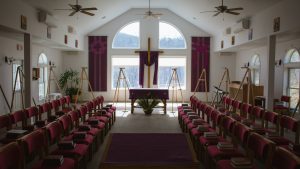
Art and artifacts
The “Trinity” altar, pictured above, has been a part of St. Peter’s for many years. The crafter is unknown, as there is no identification on the woodwork. It is likely more than a century old. The altar was used for years at the Second Street location (see photo in history section), but at some point when the parish was located alongside Tunkhannock Creek, this altar was replaced by a larger structure. After the flood of Hurricane Ivan, and the parish’s relocation to Tioga Plaza, Mary Lynn Loftus (now deceased), owner of the Mary Go Round Gift Shop, contacted the Rector and said that she had the first altar. It had been in use in her house as a dresser table, but apparently she knew its history and wanted it returned to it’s original use. She generously returned it to the parish sometime around 2006, and it was relocated to the current campus in October 2012.
The altar has several distinguishing features. The three circular holes carved in the center of the longitudinal cross brace reference the Trinity. They are contained within and elongated triangle, an oblique reference to the Trinity.

Triple circles below a unitary circle
They three circular holes at the lower frame of the altar are mirrored directly above by a geometric design in the same dimension. Of the three rounded shapes, only one is hollowed. (In the Trinity, only Jesus is visible to us in person).
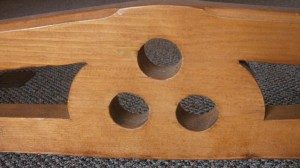
The altar also includes three arches. The front of the altar displays a single rounded arch. This feature, in an architectural setting, represents an important era in Church history. The rounded arch was first used to support large Cathedrals during the Romanesque architectural period, somewhere between the 6th to the 10th century.
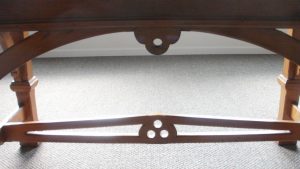
Front face of altar
The sides of the altar are distinguished by identical arches (depicted below). The design does not reveal a complete arch, but the eye is led to believe that they would meet in a point. The side arches are only partially visible if the observer is at a distance and directly in front of the altar (as would be the case during the Eucharist service). The pointed arches represent a key feature of the Gothic style cathedrals, which followed the Romanesque period.
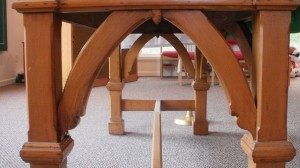
Pointed arches are notable because they solved a problem in cathedral design created by the rigid geometry of semi-circular arches (the height was limited by the diameter). Pointed arches enabled arches of different spans to rise to the same height. The pointed arch, along with ribbed vaulted ceilings and flying buttresses, allowed construction of higher, more open and well lighted cathedrals. St Peter’s worship space is blessed to be well lighted and open, with spacious ceilings.
The Ombri: Georgette Piper’s letter


The 2001 hand written letter was found in the altar guild room in 2019 by Maria Thorne. Maria typed it for our records:
This is the story of what we have been calling a “tabernacle”.
It came in my possession in1974 in a rather strange way. Bechtel Corp. had given my husband an assignment for the building of a refinery in Lawrenceville, Illinois. A friend who had been with us in Tunkhannock on the building of P&G had located a house for us in Vincennes, Indiana, just across the Wabash River. While there, I became friends with the wife of a young engineer. One day she simply appeared at my door with this object and said she had gotten it in the local antique shop for $5.00 because a Catholic Church was renovating and took these items to the antique shop for sale. I offered to pay Joy, but she said, “No. No, its something you should have.” She was an interesting girl and I still haven’t figured out what she meant. Perhaps because I had lost my mother to cancer and my 14 month old grandson had heart surgery that summer, she though I needed some good spiritual vibrations, or perhaps it was a “Farewell” gift as we were also leaving Vincennes that year.
Back to the present. It became evident that it was getting difficult for some on the altar guild at St. Peter’s to get on knees on the Sacristy floor to get into the metal box used as a tabernacle.
In the meantime I had one day shown Laura Dowd the oak box I had carried with us on many more moves and kept in the bedroom. The utensils inside were marked: “Sick Call’” ’97, meaning 1897. Laura thought it was a tabernacle. I began to feel something akin to guilt that it sat in my bedroom while St. Peter’s and the knees of some ladies needed it. I decided to see if it could be put to use at St. Peter’s. Everyone, including Father Mike, (Michael Fill) thought it would serve many well and the Vestry knows the rest.
Father Mike thought it would be nice to trace its history. This was the most interesting experience.
I called information and discovered Vincennes had five Roman Catholic Churches. I called St. John’s. I asked the same question, “Were you renovating in 1974?” A young secretary named Claire was too young to know, but she would search the church history and call me back after the weekend. She called back and St. John’s had no renovations. Call Sacred Heart.
I called Sacred Heart, spoke to Father Schwartz who was too young to know. He passed me to Julie, an older secretary. The reply was “No, but call what the locals call the old church”, or Old Cathedral. That one was a Basilica and I was sure they had not removed while I lived there. I was told they were using their original tabernacle.
They also added I need not St. Thomas because they knew nothing was done there, but try St. Vincent DePaul.
I called St. Vincent DePaul. Again the priest was young but called what appeared to be an elderly lady to the phone, asking her the question as she was coming. Bingo.
She replied, “It wasn’t St. Vincent, but I recall the story very well. This box was not a tabernacle, but a “Sick-Call Box” and was stolen along with other items from the basement of “Old Cathedral” by a young man who attended that church and he sold them to the antique shop”. Then she added “go ahead and donate it to your church but I wouldn’t tell them it was stolen, if I were you. I told her I recall seeing a life-sized statue of the “Blessed Mother” in the antique shop. She was very beautiful and I was greatly tempted. However, since my husband tolerated my doll collection going with us on about 32 moves, I knew the packers wouldn’t appreciate packing her, and there was scarcely room for me day and I cut and other treasures. But our “box” which father Mike says is properly called an “Ombri” has certainly served over 100 years of experiences. If only it could talk. And now it serves again at St. Peter’s in Tunkhannock, Pa.
Sincerely,
Georgette Piper
P.S. I never told these churches I was an Episcopalian.
Rosewood crucifix

The crucifix above the entrance doors to the sanctuary was constructed by a local craftsman, who intended it to be displayed at his own parish. The donation was rejected by the person in authority. So he came to the Rector of St Peter’s around 2005, and his artwork was gratefully accepted. It is now the first art work that an entrant to the Sanctuary passes by. “The stone that the builders rejected has become the chief cornerstone.” Ps 118:22
Baptismal Founts
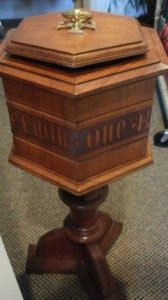
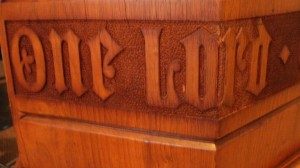

The historic Baptism fount, made of hardwood, is now used as a Holy water fount. It is inscribed with scripture often used for founts, “One Lord, one faith, one Baptism” (Ephesians 5:4).
 During the parish’s location at Tioga Plaza, (2004-2010) a memorial gift for a new glass based fount was presented, and the wood fount has been used for a Holy water fount since then.
During the parish’s location at Tioga Plaza, (2004-2010) a memorial gift for a new glass based fount was presented, and the wood fount has been used for a Holy water fount since then.
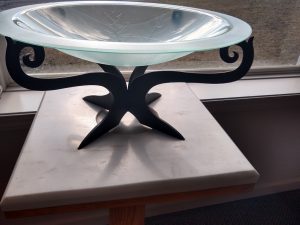
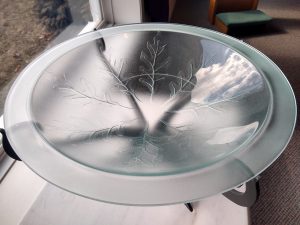
The Bell
The Meneely Bell is made of tin-copper alloy, and cast in West Troy, NY in 1882. The Meneely Company closed in 1952. The Meneely Bell Foundry was started in 1826 by Andrew Meneely in West Troy (now Watervliet). It became the Meneely Bell Co in 1874. The bell was stored at the home of the late Senior Warden Wes Spencer during the parish residence at Tioga Plaza West (2004-2010).


Icon of St Peter

The icon portrait of St Peter, with gold nimbus, depicts Peter holding the keys to the kingdom (Matthew 16:19). It was created in a style common to the Orthodox tradition. It was donated by the late Jane Shoemaker, a member of the vestry and long time parishioner. In accordance with the Orthodox art forms, it was “written” by her daughter Lindsey Place, of Tunkhannock.